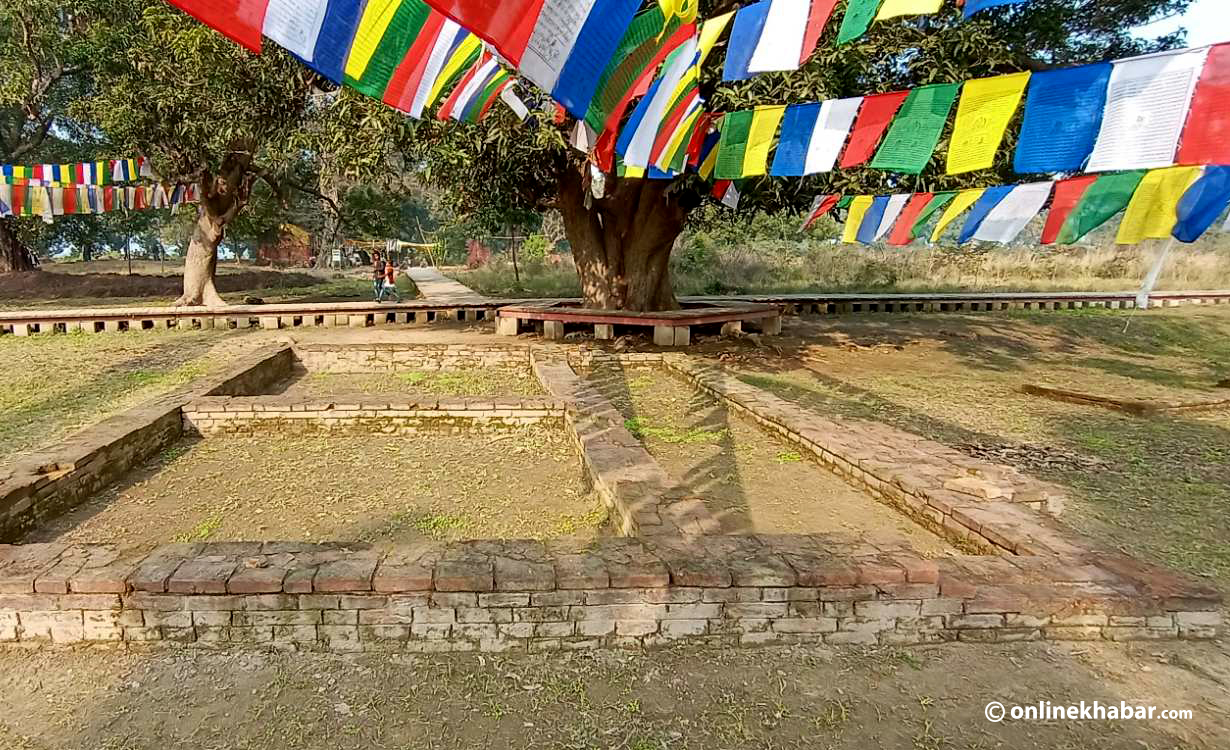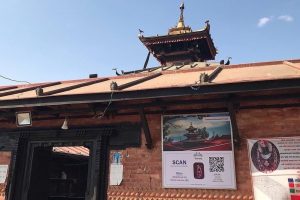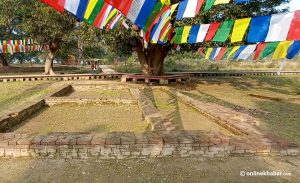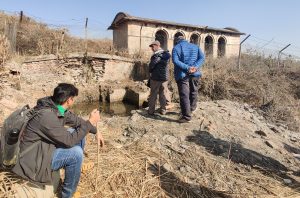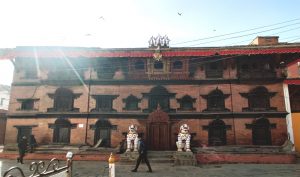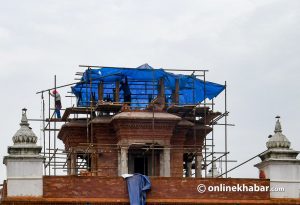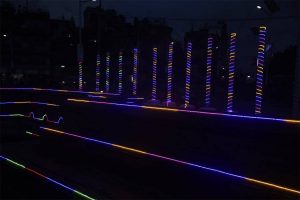In 1996, the government of Nepal selected seven additional places from the country that could be UNESCO World Heritage sites. Since then, no work has been done to implement the proposal. Lately, the government of Nepal has started preparations to list one place, Tilaurakot, out of those seven places as a World Heritage site.
The government allocated some budget for excavation this fiscal year because the government requires to submit evidence for the inclusion as the World Heritage site and a management proposal also to UNESCO after the nomination.
Lumbini was put on the World Heritage Site List within one year of the nomination by the government of Nepal. At that time as well, the government had listed Tilaurakot as a tentative World Heritage site. Now, the government has again started the nomination process by collecting enough pieces of evidence, in addition to those collected in the 1990s.
UNESCO lists any place as a World Heritage site if it meets any one of the six criteria. According to the operational guideline, the property should be a unique or exceptional testimony to a cultural tradition or to a civilisation which is living or which has disappeared. Likewise, human-made heritage sites in a certain period of time or such places in interaction with nature or environment could also be listed. Or, such heritage site should be directly linked to humans.
Although there is a lot of evidence that proves that Tilaurakot had an ancient palace of Suddhodhan, the father of Lord Gautam Buddha, the process of putting the site on the UNESCO World Heritage Site List takes a long time, informs officials of the Department of Archaeology.
Ram Bahadur Kunwar, the department’s spokesperson, assumes that it will take a minimum of four years to list Tilaurakot as a World Heritage site if the formal procedure begins now. As per Kunwar, UNESCO accepts the nominations only after completing all the procedures including interaction with locals and the consent of the local governments.
Evidence obtained during excavation

Although it has not made officially public, the capital of the ancient kingdom of Kapilvastu ruled by King Suddhodhan is today’s Tilaurakot is almost proven by a decade of excavation in that area. Kunwar says the government will submit the nomination by meeting one of six criteria set by UNESCO in accordance with the collected pieces of evidence.
Till date, 14 layers of human settlement have been found there. Also, pieces of evidence from 700 years before Budha have been found. The oldest pieces of evidence collected from the excavation in Tilaurakot are brown and red earthenware dating from the 11th century BC to the 8th century BC.
PC Mukherjee scientifically excavated this site for the first time on February 3, 1899, and proved this site as the capital of the Shakya Kingdom. He also found out exact measurements of the palace.
It has been found that a deep pit was there on each side of the place for defence purpose besides the walls, signalling a robust security system. Also, bridges were built so that people could cross those canals.
Along with strong walls on each side, there were four gates, among which archaeologists have researched only two gates to date. It has been found that the western gate was made up of bricks, wood, and iron. Archaeologist TN Mishra has described three stages of gateway construction. He believes the first and second layers of the gateway were built around the 1st and 2nd centuries BC.
Likewise, Mukherjee had discovered the eastern gate in 1899. He has also mentioned about a huge square building, unroofed, near the gate. The centre of that eastern fort’s wall that is recognised as Mahaviniskramdwar or Mangal Dwar, is the gate from where Prince Siddhartha left the palace for the journey of enlightenment to become the Lord Buddha.
Kanthak Stupa
There lies a stupa, 100 metres away from the main gate in the east. Archaeological excavations have also revealed the historicity of this stupa. It is believed that this stupa is made by placing the cremains of Kanthak, a favourite horse of Prince Siddharth, at the very place where it died.
The historical story behind this stupa is that when Sidhartha crossed the Yenoma river and officially began his spiritual journey by shaving his hair, he sent back his Kanthak horse and charioteer Chhandak from there. The horse had accomplished its purpose; that is why it is believed to have sacrificed his life before entering the entrance of the palace.
Northeast pond
There lies a huge artificial pond in the northeast corner of the palace. The old pond is believed to have been built for the recreation of the Shakya family. It is also hypothesised that there is another pond to the south of the palace. Mukherjee has mentioned many ponds during the excavation of Tilaurakot. Likewise, Lalit Vistara also mentions that there are many ponds in the palace of Shuddhodhan. However, archaeological excavations have not found many ponds.
Samai Mai Temple

Samai Mai tree temple is the place of the forest goddess. A complementary part of this temple has been found in the northwestern part of the fort. As mentioned in Buddhist literature, the temple is home to ancient artefacts that appear to have been worshipped by members of the Shakya dynasty. Lalit Vistara explains in detail about the temples of the Shakya Durbar; some travelogues of early Chinese pilgrims also have some records.
Durbar Square
Japanese archaeologists led by Nakamura unearthed the ruin of a palace-like structure in the northwestern part of the fort, which they speculated to be the northern part of the old Shakya palace. It was also revealed that although it was small, it was probably a part of the main building of the palace.
Metal Workshop
TN Mishra also found remains of a metal workshop near the southern defence wall. According to him, the workshop was used to make weapons, agricultural tools, and household utensils. Metal objects have been found near the workshop. They also contained two large water collection sites, pieces of copper vessels, early copper coins, and two iron tools.
The discovery of the workshop and coins, arms plants, etc. in this area has strengthened the notion that it was the capital city of the Shakyas.
Ancient roads
Mishra has uncovered ancient roads supposed to be built between the seventh century BC and the second century AD. Some roads had stone edges on both sides. Eight-inch soled iron slags have also been found on some roads. Even the improved roads around the place add to the notion that this place was the capital of a very powerful state.
Earthenware
Different types of pottery and earthenware have been found in Tilaurakot. Painted grey ware, northern black polished ware (NBP ware), black and red pottery dating from the sixth century BC to the eighth century AD have been found.
Terracotta statues
Human statues, animal statues, toy carts, and toy materials were recovered by Devla Mitra from Tilaurakot. These idols belonged to the Maurya, Shung, and Kushan periods.
Coins
Mishra collected silver and copper coins and early wooden coins from Tilaurakot. During the excavations, coins of different sizes from different periods were found. The coins contained mainly copper items. These coins prove that the Shakya kingdom had organised trade and prosperity.
Further need of archaeological study
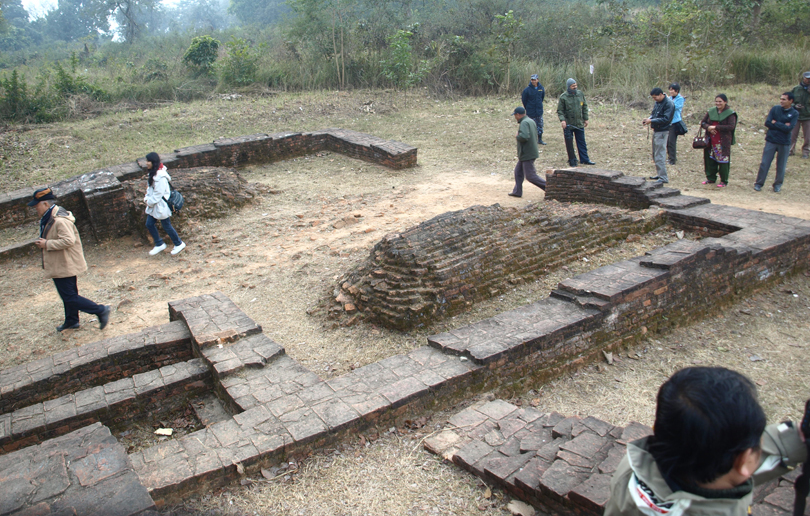
When a stone inscription with a text that says Lumbini is the birthplace of Lord Gautam Buddha was found, the search for his palace also began. For that, it was easy to get the help of literary sources first.
The Buddhist scripture Digha Nikaya mentions that Kapilvastu was situated on the bank of the Bhagirathi river in the lap of the Himalayas. Similarly, the Jataka Katha mention that Kapilvastu is surrounded by seven walls and those walls are up to 18-foot high. Literary sources also say that Kapilvastu has Kushinagar in the south, the Rapti river in the west, and the Rohini river in the east.
Likewise, Chinese pilgrim Phaiyan who came to Kapilvastu in 403 has mentioned the desolate Kapilvastu town was about 70 miles away from Lumbini. Similarly, after about 200 years, in 636, geographer Hriwensang, who came to Kapilvastu, said Kapilvastu was 30 miles from Lumbini. He is the one who mentioned the defence walls of Kapilvastu spread in the area of 2.5 miles.
In the lack of scientific pieces of evidence, all these written pieces of evidence have not been sufficient to locate the exact location of the then Sudhodhan Palace. Therefore, scientific excavations were carried out.



